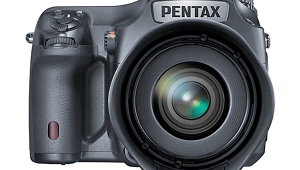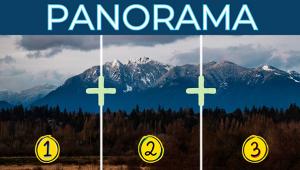photokina Special Coverage; Large Format Cameras: A Rare Treat, And “Stitchers,” Too
 Large format cameras, in the sense of "cameras that take large sheets of film," are ever rarer at photokina. There are still plenty of cameras, and sometimes (it seems) almost as many manufacturers, but because so many of the manufacturers are so tiny, making a few score cameras a year, they are known by word of mouth in the large format "fine art" community and appear at their own small, arcane gatherings. The big professional monorail market that once belonged to Linhof, Sinar, Cambo, and the like, has gone over almost entirely to digital, with much smaller sensors than the film sizes of yore, but this has in turn spawned a generation of cameras akin to the old "baby view" cameras (6x9cm/2x3"). Then there are more and more that rely on "stitching" to give big, high-megapixel files.
Large format cameras, in the sense of "cameras that take large sheets of film," are ever rarer at photokina. There are still plenty of cameras, and sometimes (it seems) almost as many manufacturers, but because so many of the manufacturers are so tiny, making a few score cameras a year, they are known by word of mouth in the large format "fine art" community and appear at their own small, arcane gatherings. The big professional monorail market that once belonged to Linhof, Sinar, Cambo, and the like, has gone over almost entirely to digital, with much smaller sensors than the film sizes of yore, but this has in turn spawned a generation of cameras akin to the old "baby view" cameras (6x9cm/2x3"). Then there are more and more that rely on "stitching" to give big, high-megapixel files.
For historical and sentimental reasons, it makes sense to start with Linhof, who showed the latest incarnation of the seemingly immortal Linhof Technika 4x5", the Master Technika 3000. The main differences--which are a good deal more significant than they may seem--are the considerably steeper drop angle on the camera bed and the ability to focus extreme wide angles.
 |
|
|
Fotoman, who came from nowhere with their rollfilm cameras, are also increasingly significant players in the large format market, albeit with some eccentric designs such as 4x10" and 8x10" handheld cameras, including the engagingly-named 810PS--"PS" standing for "Point-and-Shoot." We have an 810PS for a "road test," which will appear in due course. The 4x10" panoramic format is also gaining in popularity, which is odd because unless you can get hold of an 8x10" enlarger you are limited to contact prints; a 3x enlargement from a 6x12cm rollfilm negative (in a 4x5" enlarger) translates, with the usual 56x110mm negative, to 168x330mm (61/2x13") and should, with the minimum of care, be indistinguishable from a contact print.
Another Chinese-built camera line that deserves special mention is Shen-Hao. These used to sell on price alone, as competent though not outstanding "woodies." At photokina 2006 they had for the first time shaken off this image and had real personality and design originality. They are perhaps most reminiscent of the American Phillips brand in terms of their ingenious use of wood and sliding components, and they are available in a remarkable range of formats, including 7x17", 5x7", 4x10" (all new at the show), and significantly revised 4x5" and 8x10" formats.
The only real sticking point with Shen-Hao seems to be distribution. They are surprisingly expensive cameras, given that the best way to buy them is directly from Shen-Hao themselves. I spoke to a former US distributor and he confirmed that the margins were insufficient to allow the distributor to make a sensible profit. In one sense this is good news for the purchaser--you aren't paying a middleman--but in another it removes a great deal of support and exposure from the brand. You have to buy by word-of-mouth recommendation, and if anything goes wrong, the vendor is a long way away.
 |
|
|
Both Fotoman and Shen-Hao source their cut film holders from the same place--giveaway features bespeak a common origin--and this is good news for all large format users, as the supply of new film holders from the West looks ever more problematic. By the time you read this, Keith Canham will have ripped one of these Chinese holders apart to check its quality. If he is satisfied, we may see a sudden influx of new holders.
Canham himself announced (but did not show) his new all-metal Canham 20x24". When I saw him at the show, he was servicing a customer's camera in a back room of the Schneider booth. Not, as he said, the ideal place to do it, but convenient for the customer who was going to be at photokina anyway. This is a good illustration of how small manufacturers work.
Mike Walker was also on the Schneider stand, with his ingenious injection-molded and stainless steel field cameras that are so impervious to temperature and moisture that you could, if the mood took you, boil them. You would, however, be well advised to remove the lens, bellows, and ground glass first. He is considering making the 8x10" in olive drab; if you like the idea, contact him.
 |
|
|
Staying at the Schneider stand, their only new lens appeared to be the APO-Digitar 72mm f/5.6, seven glasses in five groups, covering 62Þ (36x48mm format). Their rivals Rodenstock (Linos) showed two new digital lenses, the APO-Sironar Digital 70mm f/5.6 (eight glasses in seven groups, covering 46x56mm) and APO-Sironar Digital HR 28mm f/4.5 (an incredible 14 glasses in 10 groups, covering 37x49mm). I was more intrigued by Rodenstock's reintroduced APO-Sironar-W 300mm f/5.6, made in a limited edition for a German dealer but also available through Canham. These lenses have not been made for around a decade, but if they sell well, other limited-run reintroductions may follow. Dollar prices had not been finalized but be warned: this is a very expensive lens.
The 300mm f/5.6 Wide is of course an ideal wide angle for ultra-large formats (above 8x10") and again this marks a trend: Canham reported that more and more people are bypassing the traditional entry-level 4x5" and going straight to 8x10" and larger formats.
- Log in or register to post comments

















































